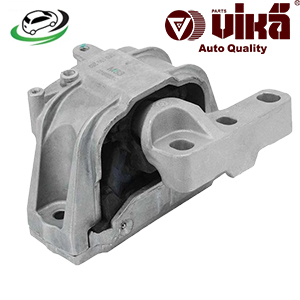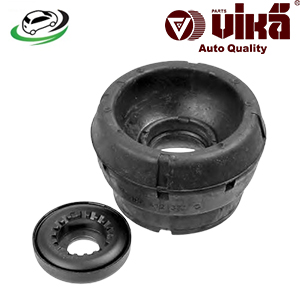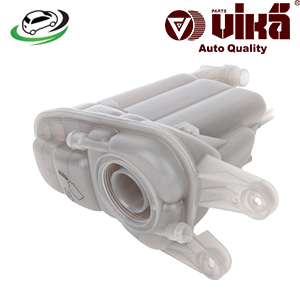-10%
Get Expansion Tank Coolant Reservoir Bottle AUDI A4 2009-2016/A5 2010-2014/Q5/S4/S5/Audi allroad 2013-2016 8K0121403Q
The expansion tank, also known as the coolant reservoir bottle, is a crucial component in a vehicle’s cooling system. It serves several important functions related to coolant management and engine temperature regulation. Here’s a comprehensive look at the expansion tank, including its construction, function, common issues, and maintenance.
Construction and Function of the Expansion Tank
Construction:
The expansion tank is typically made of durable, heat-resistant plastic, such as polypropylene or polyethylene. It is designed to withstand the high temperatures and pressures found in the engine compartment. The tank is often equipped with a cap that seals it and maintains the proper pressure within the cooling system. Some expansion tanks also have sensors or connectors for coolant level indicators or overflow pipes.
Function:
- Coolant Storage and Overflow Management:
- Primary Function: The primary function of the expansion tank is to store excess coolant that expands from the engine as it heats up. When the engine operates, the coolant expands due to increased temperature, and the expansion tank provides a reservoir for this excess coolant.
- Overflow Management: The tank allows the coolant to overflow into it when it expands, preventing excessive pressure buildup in the cooling system. As the engine cools down, the coolant contracts and is drawn back into the radiator from the expansion tank.
- Pressure Regulation:
- Sealed System: The expansion tank cap is designed to maintain a specific pressure within the cooling system. This pressure helps to raise the boiling point of the coolant, allowing the engine to operate at higher temperatures without overheating.
- Pressure Release: If the pressure exceeds the designed limit, the cap releases excess pressure, preventing damage to the radiator, hoses, and other cooling system components.
- Coolant Level Monitoring:
- Visual Indicators: Many expansion tanks have markings or indicators to show the coolant level. This allows vehicle owners or mechanics to easily check the coolant level and ensure it is within the proper range.
- Sensors: Some modern vehicles have electronic sensors in the expansion tank that monitor coolant levels and alert the driver if the level becomes too low.
- Preventing Air Pockets:
- Air Removal: The expansion tank helps to remove air pockets or trapped air from the cooling system. Air pockets can cause overheating and reduce the efficiency of the cooling system. By providing a place for air to escape, the expansion tank helps maintain the efficiency of the cooling system.
Common Issues with Expansion Tanks
1. Cracks and Leaks:
- Cracking: Over time, the expansion tank can develop cracks due to exposure to high temperatures and pressure. Cracks can lead to coolant leaks and reduce the effectiveness of the cooling system.
- Leaks: Leaks from the expansion tank can lead to coolant loss, which can cause the engine to overheat and result in potential damage to the engine and other components.
2. Cap Malfunction:
- Pressure Cap Issues: The cap on the expansion tank can malfunction or become faulty, affecting its ability to regulate pressure. A faulty cap may either release too much pressure or fail to release enough, leading to overheating or damage to the cooling system.
- Seal Failure: The seal on the cap can degrade over time, leading to leaks or improper pressure regulation.
3. Clogged Overflow Pipe:
- Blockage: The overflow pipe that connects the expansion tank to the radiator or other parts of the cooling system can become clogged. A blockage in the overflow pipe can prevent the proper flow of coolant and cause overheating issues.
4. Sensor or Indicator Failures:
- Sensor Issues: In vehicles with electronic sensors in the expansion tank, sensor failures can lead to inaccurate readings of coolant levels. This can result in the driver not being alerted to low coolant levels, leading to potential overheating.
5. Contamination:
- Coolant Contamination: Contaminants or debris in the coolant can accumulate in the expansion tank, leading to clogs or reduced efficiency of the cooling system. Regular coolant maintenance helps prevent contamination issues.
Signs of a Failing Expansion Tank
1. Coolant Leaks:
- Visible Leaks: Puddles or spots of coolant under the vehicle or around the engine bay may indicate a leak from the expansion tank.
- Low Coolant Levels: Persistent low coolant levels, despite refilling, could suggest a leak or other issues with the expansion tank.
2. Overheating Engine:
- Engine Temperature: If the engine frequently overheats, it could be due to a malfunctioning expansion tank or related components affecting coolant flow and pressure.
3. Warning Lights:
- Dashboard Indicators: Modern vehicles may have dashboard warning lights or messages indicating low coolant levels or cooling system issues. If these warnings appear, it is important to check the expansion tank and coolant levels.
4. Excessive Steam or Smoke:
- Steam Emission: Steam or smoke coming from under the hood may indicate a serious leak or overheating issue related to the expansion tank or cooling system.
5. Engine Performance Issues:
- Reduced Performance: Overheating due to cooling system issues can lead to reduced engine performance, knocking, or other performance problems.
Benefits of an Expansion Tank
1. Effective Coolant Management
Function: The expansion tank manages the overflow and contraction of coolant as the engine heats up and cools down.
Benefits:
- Prevents Overpressure: The expansion tank provides a space for the coolant to expand into as the engine heats up, preventing excessive pressure in the cooling system and reducing the risk of damage to the radiator and hoses.
- Maintains Coolant Levels: As the engine cools down, the expansion tank helps to return the coolant back to the radiator, maintaining optimal coolant levels and ensuring continuous circulation.
2. Prevention of Engine Overheating
Function: By accommodating the expanding coolant and regulating pressure, the expansion tank helps to maintain the engine at a safe operating temperature.
Benefits:
- Reduces Overheating Risks: By managing coolant levels and pressure, the expansion tank helps prevent the engine from overheating, which can cause significant damage and reduce vehicle reliability.
- Ensures Optimal Performance: Proper coolant management ensures that the engine operates within its designed temperature range, contributing to consistent performance and fuel efficiency.
3. Pressure Regulation
Function: The expansion tank cap is designed to maintain and regulate the pressure within the cooling system.
Benefits:
- Raises Boiling Point: The pressure maintained by the expansion tank cap raises the boiling point of the coolant, allowing the engine to operate at higher temperatures without boiling over.
- Prevents Pressure Damage: By regulating pressure, the expansion tank cap helps prevent damage to the radiator, hoses, and other cooling system components.
4. Coolant Level Monitoring
Function: Many expansion tanks are equipped with visual indicators or sensors to monitor coolant levels.
Benefits:
- Ease of Monitoring: Visible markings or sensors allow drivers or mechanics to easily check coolant levels and ensure they are within the recommended range, helping to prevent low coolant issues.
- Early Warning: Electronic sensors can alert the driver to low coolant levels, allowing for timely intervention and preventing potential engine damage.
5. Air Pocket Removal
Function: The expansion tank helps to remove air pockets or trapped air from the cooling system.
Benefits:
- Prevents Overheating: Air pockets can reduce the efficiency of the cooling system and cause overheating. The expansion tank helps to release trapped air, ensuring proper coolant circulation and system efficiency.
- Maintains Cooling Efficiency: By facilitating the removal of air pockets, the expansion tank helps maintain the overall efficiency of the cooling system.
6. Protection of Cooling System Components
Function: The expansion tank provides a buffer for coolant expansion and absorbs shocks and impacts from the engine.
Benefits:
- Reduces Component Wear: By managing coolant overflow and pressure, the expansion tank helps reduce stress and wear on the radiator, hoses, and other cooling system components.
- Minimizes Risk of Damage: The expansion tank helps prevent excessive pressure and overheating, reducing the risk of damage to critical cooling system parts.
7. Improved Engine Longevity
Function: Proper coolant management and pressure regulation contribute to the overall health of the engine.
Benefits:
- Extends Engine Life: By preventing overheating and ensuring proper coolant circulation, the expansion tank helps extend the life of the engine and its components.
- Reduces Maintenance Costs: Effective cooling system management reduces the likelihood of major cooling system failures, leading to lower maintenance and repair costs over time.
8. Enhanced Vehicle Reliability
Function: The expansion tank plays a key role in maintaining the overall reliability of the cooling system.
Benefits:
- Consistent Performance: Proper coolant management ensures that the engine operates efficiently and reliably, contributing to consistent vehicle performance.
- Prevents Breakdowns: By preventing overheating and managing coolant levels, the expansion tank helps avoid unexpected breakdowns and ensures reliable vehicle operation.
9. Ease of Maintenance
Function: The expansion tank simplifies the process of checking and maintaining coolant levels.
Benefits:
- Accessible Checks: The expansion tank’s location and design make it easy to check coolant levels and inspect for leaks or damage.
- Simplified Refilling: The tank provides a convenient location for adding coolant, making it easier to perform routine maintenance and top off coolant levels as needed.
10. Cost-Effective Cooling System Management
Function: The expansion tank is a relatively inexpensive component that provides significant benefits for cooling system management.
Benefits:
- Affordable Maintenance: The cost of replacing or maintaining an expansion tank is relatively low compared to the potential costs of cooling system repairs or engine damage resulting from overheating.
- Prevents Major Repairs: By effectively managing coolant levels and pressure, the expansion tank helps prevent major cooling system failures and associated repair costs.
Follow us on Facebook for more parts.





